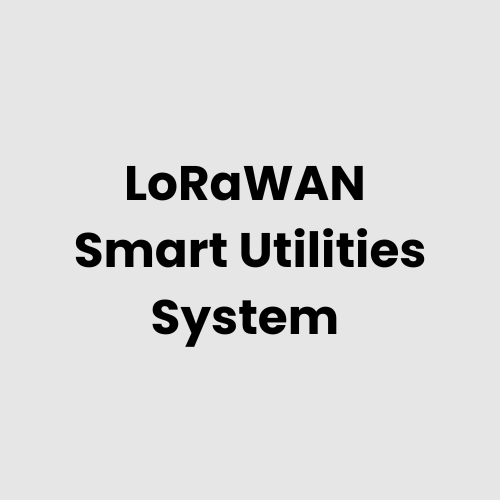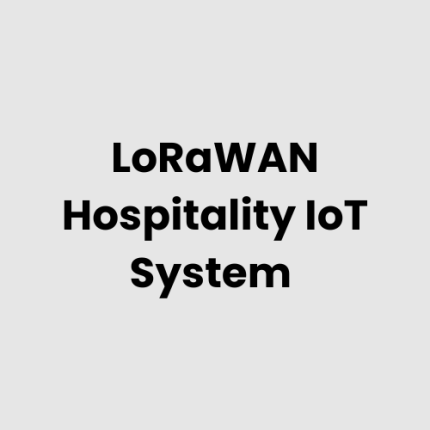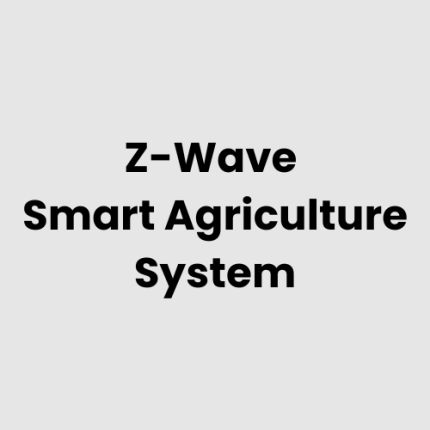Description
Technical Architecture of LoRaWAN Enabled Smart Utilities System
The LoRaWAN Enabled Smart Utilities System is designed to optimize the management of water, gas, electricity, and other utility networks by providing real-time monitoring and control through long-range, low-power connectivity. The system architecture typically consists of the following layers:
- IoT Devices Layer: Includes a wide range of sensors deployed across the utility infrastructure, such as water meters, gas sensors, energy meters, and environmental sensors. These devices continuously collect data such as consumption rates, pressure, temperature, and gas levels.
- Connectivity Layer: Utilizes LoRaWAN technology, which ensures reliable, long-range communication over vast distances with minimal power consumption. This layer connects the IoT devices to gateways, enabling them to transmit data to centralized systems.
- Edge Processing Layer: Some data processing and analytics may occur at the edge, where local computing devices handle immediate actions (e.g., controlling valves or meters) based on sensor readings, reducing the load on central servers and minimizing latency.
- Data Management Layer: This layer involves the aggregation, storage, and advanced processing of data. It may either be cloud-based or on-premises, depending on the deployment. Real-time dashboards, predictive analytics, and data visualization tools are integrated at this layer.
- Application Layer: Utility operators can monitor, manage, and control various systems, such as water distribution, power grids, or gas pipelines, through software applications that provide insights, alerts, and automation based on the data collected.
GAO Tek’s IoT solutions are ideal for deploying LoRaWAN-based smart utilities systems, offering reliable communication, scalable infrastructure, and top-tier data management.
List of Hardware for LoRaWAN Enabled Smart Utilities System
The core hardware components of a LoRaWAN-enabled smart utilities system include:
- LoRaWAN Sensors: Devices that monitor critical metrics such as water pressure, gas leakage, temperature, humidity, and energy consumption.
- LoRaWAN Gateways: Routers that relay data between IoT devices (sensors) and centralized systems, ensuring long-range communication with minimal power consumption.
- Edge Computing Units: Devices that enable local data processing, reducing the amount of data that needs to be transmitted to central servers and enabling real-time decisions.
- Utility Meters: Smart meters for measuring energy, water, or gas consumption, connected via LoRaWAN technology to transmit usage data continuously.
- Power Supply Modules: To ensure uninterrupted operation of IoT devices, especially in remote areas where traditional power sources may not be available.
- Actuators: Devices such as automated valves or pumps, which can be controlled remotely based on sensor data to optimize resource distribution.
GAO Tek’s extensive portfolio of high-performance IoT hardware supports seamless integration into utility management systems, helping companies create smarter, more efficient infrastructure.
Physical Placement Considerations of the Hardware of LoRaWAN Enabled Smart Utilities System
Effective deployment of the hardware in a LoRaWAN-enabled smart utilities system depends on several placement considerations:
- IoT Sensors: Sensors should be strategically installed in critical locations such as water pipelines, electrical meters, gas lines, and environmental points (e.g., weather stations). For optimal data accuracy, sensors should be positioned where environmental conditions fluctuate most.
- Gateways: LoRaWAN gateways should be placed in locations with broad coverage across the utility infrastructure. Elevating gateways on rooftops or in central locations within a facility can reduce interference and extend communication range.
- Edge Devices: Edge computing modules should be placed near sensors or critical infrastructure points to reduce latency and enhance local decision-making, especially when real-time control is required.
- Utility Meters: Smart meters should be installed at key points in the utility network, such as water distribution centers, residential buildings, or industrial complexes, for continuous, real-time monitoring.
- Power Modules: Power supplies must be installed in locations that ensure they are able to support long-duration, low-power IoT devices, particularly in remote areas.
GAO Tek can assist in planning and executing the optimal physical placement of hardware to ensure seamless, reliable performance across large-scale utility networks.
Hardware Architecture of LoRaWAN Enabled Smart Utilities System
The hardware architecture of the LoRaWAN-enabled smart utilities system is designed for reliability, scalability, and flexibility:
- IoT Devices: These include water flow sensors, pressure meters, environmental sensors, and gas detectors. These devices transmit data continuously or at specified intervals to the nearest gateway.
- LoRaWAN Gateways: Gateways connect multiple IoT sensors to the centralized control system. They operate over long distances and are capable of handling multiple connections simultaneously.
- Edge Computing Units: Located at strategic points within the network, edge devices process data from IoT sensors locally, reducing the need to transmit large volumes of raw data to centralized systems.
- Centralized or Cloud Server: This system aggregates data from multiple gateways, storing it for historical analysis and real-time monitoring. Advanced analytics and predictive maintenance models can be run on this server.
- Control Units/Actuators: Actuators, such as automated valves, pumps, or circuit breakers, are controlled based on the data received from IoT sensors, enabling automation in the utility infrastructure.
GAO Tek provides integrated solutions for the entire hardware architecture, ensuring smooth communication between devices, efficient data processing, and centralized control of utility systems.
Deployment Considerations for LoRaWAN Enabled Smart Utilities System
Successful deployment of a LoRaWAN-enabled smart utilities system requires careful consideration of several key factors:
- Coverage Area: Plan gateway placement to ensure reliable communication across large utility networks. LoRaWAN technology is effective for long-range communication, but the deployment must account for obstacles and interference.
- Power Efficiency: LoRaWAN devices are designed for low-power operation, but power management remains critical, especially in remote or hard-to-reach locations. Consider energy harvesting solutions for long-term deployments.
- Data Security: Implement strong encryption and secure data transmission protocols to ensure that sensitive utility data is protected from unauthorized access or cyber threats.
- Scalability: Design the system to be scalable, allowing for the addition of more sensors or gateways as the utility network expands or new sensors are needed for additional monitoring points.
- Environmental Factors: Ensure that all hardware is ruggedized for outdoor or industrial environments, with adequate protection from weather, temperature extremes, and potential physical damage.
- Network Reliability: Ensure the system is designed with redundancy in mind, including backup power supplies for gateways and critical sensors to prevent downtime.
GAO Tek’s expertise in deployment and planning allows us to assist in creating a tailored deployment strategy that meets the unique requirements of each utility system.
List of Relevant Industry Standards and Regulations
- IEEE 802.15.4 (Low-rate wireless personal area networks)
- IEEE 802.11ah (Wi-Fi HaLow)
- ETSI EN 302 618 (LoRaWAN Technical Standards)
- ISO 50001 (Energy management systems)
- IEC 61850 (Communication networks for power utilities)
- FCC Part 15 (Unlicensed wireless communication regulations)
- EN 301 489 (Electromagnetic compatibility requirements)
- ISO/IEC 27001 (Information Security Management)
Local Server Version of LoRaWAN Enabled Smart Utilities System
In environments where data privacy or internet connectivity is a concern, a local server version of the LoRaWAN-enabled smart utilities system can provide a solution. This version processes and stores data on-site, offering enhanced control over data security, reduced latency, and better real-time decision-making.
By using local servers, utility companies can avoid reliance on cloud services, ensuring that critical operational data is stored and analyzed within their own infrastructure. GAO Tek’s solutions can be adapted to support local server setups, providing custom software and hardware configurations that meet the specific needs of each utility.
Cloud Integration and Data Management
Cloud integration in a LoRaWAN-enabled smart utilities system provides scalable data storage, advanced analytics, and remote access to data. Key benefits include:
- Centralized Data Storage: All data from IoT sensors, gateways, and edge devices is aggregated in the cloud, making it accessible for analysis, reporting, and long-term storage.
- Real-Time Analytics: Cloud platforms enable advanced analytics, providing real-time insights into utility performance, usage patterns, and predictive maintenance.
- Remote Monitoring and Control: Utility managers can remotely access the system via cloud-based applications, receiving alerts, monitoring operations, and making adjustments as needed.
- Scalability: The cloud architecture allows for easy scaling, enabling utility companies to expand their monitoring capabilities as their networks grow.
- Data Security: Advanced encryption and secure transmission protocols ensure that all data handled in the cloud is protected against cyber threats.
GAO Tek’s cloud integration solutions ensure that your LoRaWAN-enabled smart utilities system is future-proof, scalable, and equipped with the advanced data management tools needed to optimize utility operations.
GAO Case Studies of LoRaWAN Enabled Smart Utilities System
Case Studies in the USA
- San Francisco, California
In San Francisco, LoRaWAN technology was used to implement a smart water management system, allowing for real-time monitoring of water consumption and leak detection. The system helped reduce water waste by providing insights into infrastructure efficiency, with automated alerts sent to city officials for rapid response.
- Austin, Texas
A smart energy grid system in Austin used LoRaWAN to connect various meters and sensors across residential and commercial properties. This enabled continuous monitoring of energy consumption patterns and the efficient distribution of electricity, optimizing load balancing and improving grid stability.
- Chicago, Illinois
Chicago’s smart gas system, utilizing LoRaWAN-enabled sensors, provides real-time data on gas pressure and leakage. The system enables immediate detection of potential hazards and helps the city take proactive steps to mitigate risks, enhancing overall safety for residents.
- Los Angeles, California
In Los Angeles, LoRaWAN sensors were deployed across stormwater management systems to monitor water levels and prevent flooding during heavy rainfall. The system provided accurate data to local authorities, allowing them to manage water flow efficiently and mitigate potential damage.
- New York City, New York
New York City integrated LoRaWAN-based smart meters for both water and energy usage monitoring in commercial buildings. This initiative aimed at reducing utility costs and improving energy efficiency through real-time data collection and predictive analytics for maintenance needs.
- Denver, Colorado
Denver’s waste management system was enhanced with LoRaWAN sensors placed in dumpsters and trash bins across the city. The system tracks fill levels and optimizes waste collection routes, reducing operational costs and minimizing environmental impact.
- Miami, Florida
In Miami, a smart irrigation system based on LoRaWAN sensors was deployed to monitor soil moisture levels in parks and green spaces. The system allows for optimized watering schedules, ensuring water conservation while maintaining the health of the city’s landscaping.
- Seattle, Washington
Seattle’s smart water network uses LoRaWAN technology to monitor water distribution systems across the city. Real-time pressure and flow data help detect leaks and prevent disruptions, leading to better resource management and cost savings.
- Dallas, Texas
A smart energy monitoring system in Dallas used LoRaWAN to connect electrical meters across homes and businesses. This solution provided granular data on energy consumption, allowing utilities to offer more personalized services and optimize grid performance.
- Phoenix, Arizona
Phoenix leveraged LoRaWAN-based water meter sensors for residential properties. The system helped track water usage patterns and identify leaks or inefficiencies, contributing to water conservation and helping the city meet sustainability goals.
- San Diego, California
San Diego’s smart gas pipeline system uses LoRaWAN sensors to monitor gas pressure and flow in real time. The system alerts maintenance teams to potential leaks and irregularities, reducing response time and ensuring safer gas distribution.
- Boston, Massachusetts
In Boston, a smart energy management system utilizing LoRaWAN technology was implemented to monitor streetlights and public infrastructure. The system allowed for automatic dimming based on real-time data, significantly reducing energy consumption and utility costs.
- Portland, Oregon
Portland’s water distribution network was upgraded with LoRaWAN-based smart sensors to monitor pressure and consumption rates. The system’s real-time data helped optimize water distribution and reduce instances of leaks or inefficiencies in the system.
- Salt Lake City, Utah
Salt Lake City deployed LoRaWAN technology in its smart gas monitoring system. The system continuously collects data from sensors embedded in pipelines to detect any irregularities or safety concerns, ensuring timely repairs and minimizing potential hazards. - Indianapolis, Indiana
Indianapolis implemented a LoRaWAN-based waste bin management system. The city placed sensors in trash bins across neighborhoods, optimizing waste collection routes and schedules, ensuring timely pickups and reducing unnecessary carbon emissions from waste trucks.
Case Studies in Canada
- Toronto, Ontario
Toronto adopted LoRaWAN-enabled smart meters for both water and energy usage monitoring in residential areas. These meters provided real-time usage data, improving energy efficiency and reducing costs for both residents and utility providers, while also helping the city meet sustainability targets. - Vancouver, British Columbia
Vancouver implemented a LoRaWAN-based smart irrigation system to monitor soil moisture levels in public parks. This system optimized irrigation schedules, conserving water and promoting environmental sustainability across the city’s green spaces.
Navigation Menu for LoRaWAN
Navigation Menu for IoT
- LORAWAN
- ZIGBEE
- Wi-Fi HaLow
- Z-WAVE
- BLE & RFID
- NB-IOT
- CELLULAR IOT
- GPS IOT
- IOT SENSORS
- EDGE COMPUTING
- IOT SYSTEMS
Our products are in stock and can be shipped anywhere in the continental U.S. or Canada from our local warehouse. For any further information, please fill out this form or email us.
We are actively looking for partners who are like us located in the U.S. and Canada. For more information on partnering with GAO, please visit Partner with GAO Tek Inc. It lists various ways to partner with GAO, such as OEM Partnerships, Technology Integration, Distribution and Reselling Opportunities, Presenting at the Leading Event Tek Summit, Joint R&D Projects, Training and Consulting Services, Industry-Specific Collaborations, Research and Academic Partnerships.



